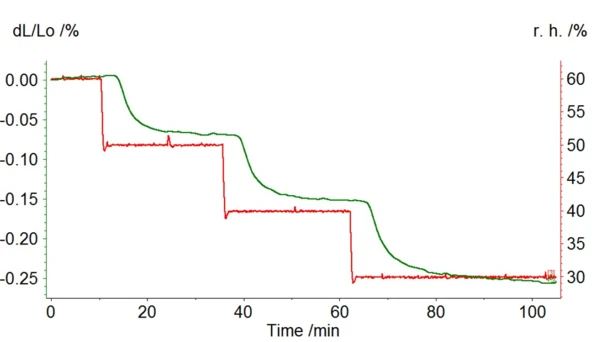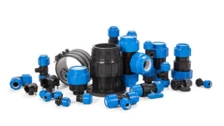
26.05.2020 by Milena Riedl, Doreen Rapp
How to Measure the Expansion of Materials Due to Water Uptake
In the previous articles, focusing on thermal analysis under humidity, we have seen that thermogravimetric analysis and dynamic mechanical analysis help determine the influence of water on a material or substance. Thermomechanical analysis complements the analysis under humidity.
In the previous articles, focusing on thermal analysis under humidity, we have seen that thermogravimetric analysis is a standard method for the identification of water absorption and the determination of moisture content. Furthermore, dynamic mechanical analysis additionally helps determine the influence of water and humidity on the mechanical properties of a material and part.
The thorough analysis of a material or substance under humidity is completed with thermomechanical analysis.
Hands-on: TMA measurements under humid atmospheres
What is thermomechanical analysis?
Thermomechanical Analysis (TMA) determines dimensional changes of solids, liquids or pasty materials as a function of temperature and/or time under a defined mechanical force. It is closely related to Dilatometry, which determines the length change of samples under negligible load.
An example from the field of polymers
The objective of the following analysis is the determination of the length change of the material in a humid atmosphere. Therefore, a TMA 402 F1 Hyperion® was equipped with a humidity generator that produces a defined humidity level by mixing wet and dry gas flow.
The experiment was carried out on a 250-μm foil sample with a length of 14.93 mm in tension mode. The temperature was held constant at 40°C and humidity steps of 25 % were performed during the temperature program (blue curve in figure 1).

In figure 1, it becomes clear that there is a total increase of more than 300 μm. The sample’s length change was caused by the increase in water content in the material as a result of water absorption. This length change of a material under humidity needs to be taken into account when constructing polymer parts for different applications.
The combination of results of different thermal analysis methods allow for further interpretation
The good correlation between the different methods allows for further interpretation. TGA analysis shows that there is a physical interaction of water and humidity with a material or substance. This can be seen as an increase in moisture content and not a Reazione di DecomposizioneLa decomposizione è la reazione indotta termicamente con cui una sostanza chimica genera prodotti solidi e/o gassosi. decomposition behavior of the sample. Subsequently, analyses with TMA and DMA show the resulting property change, e.g., expansion process and/or changes in the mechanical properties.

Let’s have a look at other applications!
An application from the field of cosmetics
In this experiment, a human hair was analyzed at a constant temperature of 45°C with different kinds of humidity level from 30 to 60% relative humidity. The hair changes its length due to decreasing humidity.

Today, analysis of human hair is mainly used in the field of cosmetics in order to find out how the human hair reacts to different kinds of climatic conditions and how a shampoo or conditioner can influence the reaction of the hair.
An application from the field of building materials
For the measurement of wood, samples were cut in different ways, illustrated in this picture.

Wood has a high anisotropy regarding its interaction with water and the subsequent expansion. The length change due to water uptake depends on the direction the wood sample has been prepared. Cut in longitudinal direction, the length change of a wood sample expands about 0.1%, while in radial direction, the expansion reached nearly 1%, and in tangential direction up to 2%.

There is a factor of 20 in the length change between the different directions. Therefore, wood is treated with different substances in order to make it more resistant to different weather conditions.
The previous examples clearly show that humidity is one of the essential property-defining parameters of materials.
Thermal analysis instruments can give vital insight into the water absorption of materials and substances as well as help determine the resulting length expansion or changes in mechanical stability.

